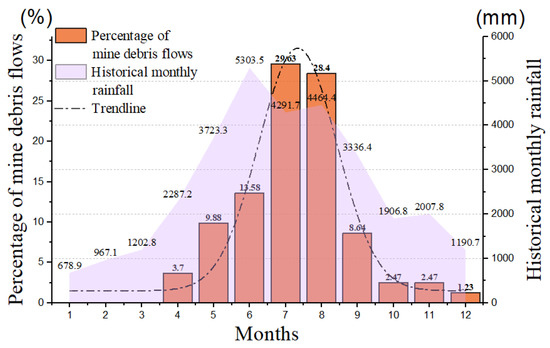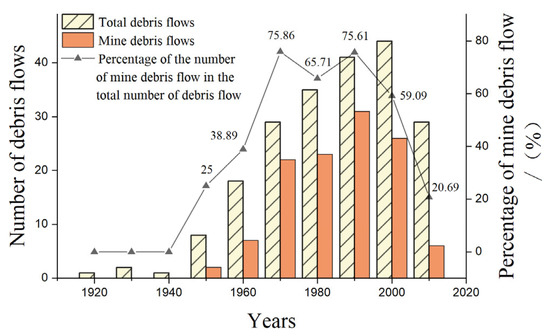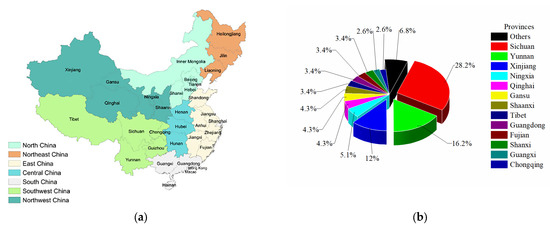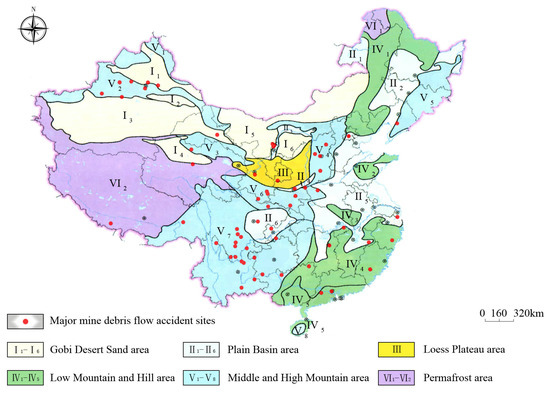From 从1954 to 2019, the number of major mine debris flow disasters first increased and then decreased. The proportion of mine debris flow disasters to the total number of debris flow disasters also showed a trend of first increasing and then decreasing, with the southwestern region being the area of high occurrence of mine debris flow, and the geoenvironmental areas of middle and low hills and middle and high mountains being the topographic areas of high occurrence of mine debris flow. More than 90% of the major mine debris flow disasters occurred from May to September, with the largest number of disasters occurring in July.年到2019年,重大矿山泥石流灾害数量先增加后减少。矿山泥石流灾害占泥石流灾害总数的比例也呈现出先增后减的趋势,西南地区是矿山泥石流高发区,中低山和中高山的地质环境区是矿山泥石流高发的地形区。90%以上的重大矿山泥石流灾害发生在5-9月份,其中7月份发生的灾害数量最多。
- mine debris flow
- spatial-temporal distribution
- variation patterns
1.Introduction介绍
2. Status of Research on Mine Debris Flow
2.1. Status of International Mine Debris Flow Research
With the growth in the number and scale of mines worldwide, the risk of geological hazards arising from the mineral extraction process have received increasing attention, and in developing countries, there is a tendency for mine geological hazards to be exacerbated by outdated mine waste rock disposal management systems [3][4][5][6][5,6,7,8]. Some scholars have argued that despite the large number of open pit mines with unique and large topographic features such as drainage dumps and tailings ponds, it may be difficult to identify the impacts from human mining activities at smaller spatial and temporal scales from natural processes [7][8][9,10]. In this regard, the interactions and synergistic effects of direct and indirect impacts of human mining activities, topographic factors, ecological factors and climatic factors at different spatial and temporal scales are quite complex [9][10][11,12]. By altering the topography as well as the ecosystem, mining activities not only increase the frequency of low-intensity accidents, but also induce catastrophic accidents in some environments [11][13]. Although the occurrence of some mine debris flow accidents is mainly associated with natural forces, such as heavy rainfall, the anthropogenic alteration of the mine environment—especially the large amount of loose solids generated by mining activities—may have exacerbated the scale and impact of the hazard. Based on this, many researchers [12][13][14][15][16][14,15,16,17,18] believe that studies on the spatial and temporal distribution patterns of accident sites, such as open pits, dumps, and tailings ponds where geological hazards occur, can help determine their intrinsic correlation with natural factors such as climate and topography. Increasingly, research institutions are recognizing the geohazard risks posed by mines and are attempting to assess the distribution of mine sites and mine spoil disposal volumes on a national scale. In South Africa, it is estimated that 1100 mines produce 72.3% of the country’s total mine spoil while occupying 25 km2 of land for tailings pond construction [17][19]. In Australia, more than 80,000 abandoned mines are recorded, posing a considerable threat to the surrounding area [18][20], in addition to more than 1750 tonnes of mine spoil from operating mines each year [19][21].2.2. Progress of Mine Debris Flow Research in China
Research on mine debris flows in China started in the 1950s. Wang et al. [20][22] started early to evaluate the prediction of debris flows in mines through three aspects: storm intensity, solid material sources and topographic conditions, and established a qualitative prediction system for mine debris flows. Xie [21][23] gave the first systematic overview of the application of fractal theory in geotechnics, providing a powerful new tool for the study of debris flow problems. Xu et al. [22][23][24,25] gave a more comprehensive discussion on the conditions and characteristics of mine debris flow formation, focusing on the analysis of mine debris flow and its distribution characteristics in Northwest China, and classified mine geological problems according to their occurrence in time, space, geological environment background, resulting outcomes, and recoverable degree in order to promote research on mine geological environment management. Many researchers have studied the distribution characteristics of mine geological hazards [24][25][26][26,27,28], and concluded that mine debris flow, as one of the common types of mine geological hazards, has the characteristic of being extremely destructive and a serious threat to normal production and human ecological environment in mining areas. Therefore, the distribution pattern was analyzed from both temporal and spatial perspectives, and it was concluded that major mine geological hazards are the main cause of human casualties and property losses, and should be focused on in future studies.3. Analysis of the Time Variation Pattern of Mine Debris Flow
3.1. Intra-Year Variation Pattern of Mine Debris Flow
The distribution of major mine debris flow disasters in each month from 1954 to 2019 were collated to obtain Figure 1. Statistics show that most of the major mine debris flow disasters in China occur from May to September, with the number of occurrences accounting for more than 90.1% of the total number of 12 months. The frequency of occurrence is higher from June to August, and the largest number of disasters occurs in July, accounting for 29.6% of the total. Major mine debris flows rarely occur from January to March and December. The fitted trend lines show that the distribution of disaster occurrence periods are concentrated between July and August. Considering that China is mainly influenced by continental monsoon climate, with warm and humid summer winds blowing from the east and south oceans from April to September every year, rainfall is mostly concentrated in summer. The trend of precipitation in each month overlaps highly with the trend of major mine debris flow disasters. The historical monthly precipitation totals are low during the low frequency of major mine debris flow in January to March and December, while the total amount of precipitation is at a high level during the high frequency of major mine debris flow in May to September, which confirms that the intra-year distribution trend of major mine debris flow disasters is largely influenced by the precipitation factor during the flood season (China’s flood season is from May 1 to October 20 each year).
3.2. Interannual Variation Pattern of Mine Debris Flow
The trends in the number of major debris flow disasters and the number of major mine debris flow disasters occurring over a long period of time, obtained based on the collected data, are shown in Figure 2. The percentage of the number of mine debris flow in the total number of debris flow occurrences in each period is also shown in the figure.
4. Analysis of the Spatial Distribution Pattern of Mine Debris Flow
4.1. Mine Debris Flow Distribution Pattern by Province
Analyzing the spatial distribution pattern of mine debris flow hazards is the basis for analyzing and assessing their causes and influencing factors, and thus, predicting their development trends. Based on the statistical data from 1954 to 2019, the national percentage of major mine debris flow disasters in different provinces obtained by collation is shown in Figure 3.
4.2. Mine Debris Flow Distribution Pattern by Geological Environment Zone
As a geological hazard specific to mining areas, mine debris flow, like natural debris flow, requires specific topography as a basic condition, so mountainous areas with high and steep terrain, gullies and valleys, rich in unconsolidated soil, and highly weathered rocks are prone to mine debris flow. On the other hand, various metallic and non-metallic minerals are mostly produced in mountainous areas, and mining activities destroy the geological environment of mining areas and pile up large amounts of mine waste rock and slag, which intensify the occurrence, development, and hazards of mine geological hazards, making mine debris flows one of the most common and costly geological hazards in many mountainous areas. Combined with the collected data on the distribution of major mine debris flow, the distribution map of major mine debris flow was drawn using the China Mine Geological Environment Background Zoning Map [27][29] as the base map (Figure 4).
5. Regional Comprehensive Evaluation of Mine Debris Flow Distribution
The analysis of the distribution pattern of major mine debris flow, the clarification of the key areas of mine debris flow disaster prevention, and the formulation of localized counter measures for mine debris flow prevention and control on a national scale can help improve the economy, accuracy and effectiveness of prevention and control measures, and provide great benefits for China’s disaster prevention and mitigation work. Combined with the previous summary of the law of temporal change and spatial distribution of mine debris flow, the influencing factors of the distribution of major mine debris flow are extracted and combined with the AHP hierarchical analysis method to make a regional comprehensive evaluation of the possibility of mine debris flow occurrence.5.1. Selection of Impact Factors and Determination of Their Weights
Influencing factors mainly come from two aspects, natural environmental factors include: ① topography and geomorphology: landform types and distribution, elevation, gully bed ratio and shape, slope, gully density; ② Geological conditions: rock formations, geological structure, stratigraphy, regional mineral profile, tectonic movements, lithologic characters; ③ meteorology and hydrology: surface runoff, watershed area, unit rainfall, frequency and intensity of heavy rainfall; and ④ vegetation cover. Anthropogenic factors include: intensity of mining activities, changes in ground structure, unreasonable piling and discharging of mining waste, stability of structures, ecological impact, input of prevention, and control measures. Many factors are interrelated and work together to make the spatial and temporal distribution of major mine debris flows complex and variable. In order to explore their intrinsic links, the geological environment, tectonic conditions, multi-year average daily maximum precipitation, vegetation cover, and human factors of major mine debris flow occurrence were selected as evaluation factors based on the collected data combined with the relevant literature [28][29][30][30,31,32]. The AHP hierarchical analysis was applied to compare the importance of the factors in the hierarchical model using the “1–9 Scale Method”; moreover, psychological experiments have shown that this method can reflect the ability of most people to discriminate between different things of the same attributes and is widely known and applied. The results of the AHP hierarchical analysis based on the judgment matrix are listed in Table 1. The detailed calculation process is as follows:-
The judgment matrix is normalized by column vector to obtain the new matrix.
-
The new matrix is summed by rows to obtain the column vector ω, which is the eigenvector of the judgment matrix.
-
The column vector changes to the weight vector W after normalization, i.e., the vector composed of the weight values Wi.
-
Combined with the eigenvector ω, the maximum eigenroot λmax = 5.243 can be calculated.
-
Then, the CI = 0.061 is calculated using the maximum eigenroot value.
-
The query obtains the average random consistency index RI = 1.120 for the fifth order judgment matrix.
| Item | Eigenvector ( | ω | ) | Weighting Value ( | Wi | ) | Maximum Eigenroot ( | λmax | ) | CI |
|---|---|---|---|---|---|---|---|---|---|---|
| Geological environment | 0.672 | 13.435% | 5.243 | 0.061 | ||||||
| Geological environment | middle and high mountain areas | low mountain and hilly areas | plain basin areas and permafrost areas | Gobi Desert sand areas and Loess Plateau areas | Tectonic conditions | 0.339 | 6.778% | |||
| Tectonic conditions | high degree of tectonic development, many loose deposits, high intensity of neotectonic activity | high degree of tectonic development, many loose deposits, low intensity of neotectonic activity | medium degree of tectonic development, few loose deposits | low degree of tectonic development, few loose deposits | Multi-year average daily maximum precipitation | 2.514 | 50.282% | |||
| Multi-year average daily maximum precipitation | 100–200 mm | 50–100 >200 mm |
<50 mm | Vegetation cover | 0.174 | 3.482% | ||||
| Anthropogenic factors | 1.301 | 26.023% |
5.2. Comprehensive Evaluation Model
The evaluation factors are graded and assigned a score Fi according to the proportion of significant mine debris flow occurring in different spatial and temporal conditions to the total statistics combined with the qualitative analysis of the impact degree to achieve quantification (Table 2). The evaluation of mine debris flow distribution area is calculated by multi-factor composite index method, and the composite index F is the comprehensive quantitative value of mine debris flow distribution area evaluation, and the threshold value is set according to the size of F to grade the mine debris flow distribution area. The comprehensive index of mine debris flow distribution area evaluation is obtained by the weighted superposition calculation of each evaluation factor, and its calculation model is:
| F | i | 0 | 3 | 7 | 10 |
|---|---|---|---|---|---|
| - | |||||
| Vegetation cover | <10% | 10–30% | 30–60% | >60% | |
| Anthropogenic factors | high intensity of mining activities, the existence of unreasonable pile and row, engineering instability | high intensity of mining activities with impact on environment and geotechnical stability | medium intensity of mining activities, high engineering stability | low intensity of mining activities, high engineering stability, with prevention and control works |
